#oberlin conservatory
Text
Attn Oberlin College Alumni
Hi, if you're out there! If I know anything about Obies, some of you are definitely still on tumblr. I'm putting out this call to ask you to join the call for Oberlin to divest.
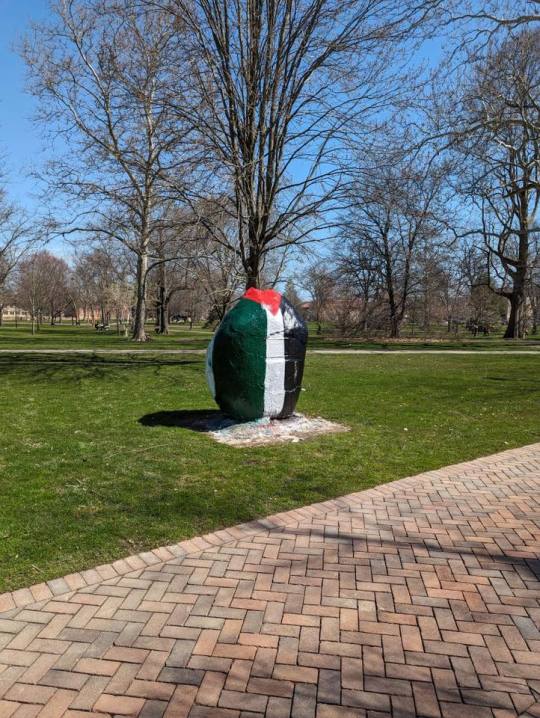
We're asking you to read the divestment information linked above, then sign this to show the Board of Trustees you agree with the student proposal. Then, as a step two, sign this pledge, saying you won't be donating to Oberlin until they divest from Israel.
Thanks for taking a minute to read this and act, please message me if you have any questions!
#oberlin#oberlincollege#oberlinconservatory#oberlinohio#oberlin college#oberlin conservatory#oberlin ohio
5 notes
·
View notes
Text

Congratulations to Rhiannon Giddens, who will deliver the keynote address at Oberlin College and Conservatory’s Class of 2024 Commencement ceremony on Monday, May 27, which will be livestreamed. Giddens, who studied opera at the Conservatory and graduated in 2000, will be awarded an Honorary Doctor of Music degree during the ceremony. "A consummate musician, equally noteworthy for her accomplishments as a performer, composer, scholar, lyricist, and more, Rhiannon Giddens stands as one of the most important creative and artistic voices of our time," Dean of the Conservatory William Quillen says. "Throughout her work, Giddens has brought to light previously overlooked or suppressed voices and histories.” Read more here.
#rhiannon giddens#oberlin college#oberlin conservatory#honorary doctorate#commencement 2024#nonesuch#nonesuch records
1 note
·
View note
Text
Broadway Divas Tournament: Round 2A


Christine Baranski (1952)
"CHRISTINE BARANSKI (Charlotte) last appeared in the Playwrights Horizon’s workshop production of Stephen Sondheim’s Sunday in the Park with George. Just prior to that she appeared in the New York Shakespeare Festiva’s production of A Midsummer Night’s Dream for which she received an Obie Award. She also recently completed filming Louis Malle’s new movie Crackers in which she co-stars with Donald Sutherland. Other New York credits include Sally and Marsha with Bernadette Peters at the Manhattan Theatre Club; The Undefeated Rhumba Champ at the Ensemble Studio Theatre and Coming Attractions at Playwrights Horizons. Her films include Playing for Time with Vanessa Redgrave, Lovesick, and Soup for One. She has worked at Center Stage in Baltimore, Chicago’s Goodman Theatre and the McCarter Theatre in Princeton as well as the American Shakespeare Festival in Stratford, Connecticut. Christine is a graduate of the Julliard School and is the happy bride of actor Matthew Cowles.” – Playbill bio from The Real Thing, May 1984
Judy Kuhn (1958)
“JUDY KUHN (Alice/Succuba/Citizen/Miss Isabel Yearsley) is making her Broadway debut in Drood and was a member of the original company in Central Park last summer. Off-Broadway she received critical praise for her performance in the Jewish Repertory Theatre’s production of Pearls. Before that she was seen with Yul Brynner’s farewell tour of The King and I. Roles in stock productions include Maria in West Side Story, Julie in Carousel, Rosamund in The Robber Bridegroom. Judy is a graduate of the Oberlin Conservatory of Music and studies acting with John Stix.” – Playbill bio from The Mystery of Edwin Drood, April 1986.
NEW PROPAGANDA AND MEDIA UNDER CUT: ALL POLLS HERE

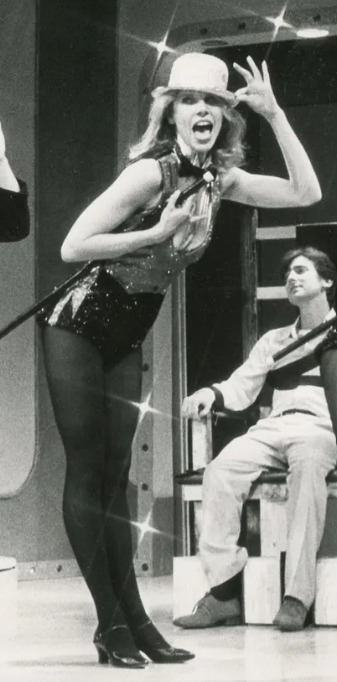

youtube
"With the devastating elimination of Patti LuPone, Christine Baranski may well be our reigning *Diva* in the most literal sense of the word. Are you truly worthy of the title if you don't inspire drag egos? Go on, close your eyes right now and picture a living Broadway Diva. Baranski is going to be on that list every time."



youtube
"Four-time Tony loser Judy Kuhn is a sad sentence to type. But hey, at least she's in good company with Elaine Stritch. Judy doesn't need a fancy trophy to prove how talented she is. She's booked and busy, and aren't we glad for it?"
#broadwaydivastournament#broadway#broadway divas#tournament poll#christine baranski#judy kuhn#round 2a
44 notes
·
View notes
Text
Walter Franklin Anderson
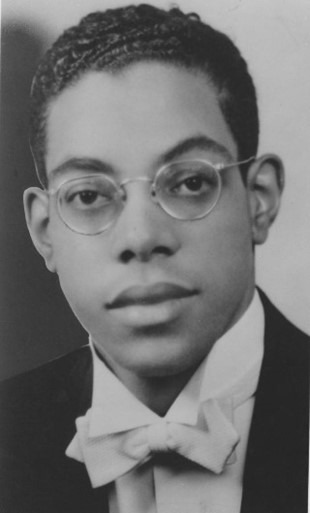
The grandson of formerly enslaved people, Walter Franklin Anderson, classical pianist, organist, composer, jazz musician, community activist, and academician, was born on May 12, 1915, in segregated Zanesville, Ohio. Walter was the sixth of nine children of humble beginnings.
Information regarding his parents is not available. Anderson, a child prodigy, began piano studies at age seven, and by 12, he was playing piano and organ professionally while still in elementary school. He was the only Black student to graduate from William D. Lash High School in Zanesville in 1932. Although a talented musician, Anderson was not a member of any of the school’s music ensembles, including the Glee Club or orchestra. Afterward, he enrolled in the Oberlin Conservatory of Music in Oberlin, Ohio, 100 miles north of his hometown, and received a Bachelor of Music in piano and organ in 1936. Anderson continued his studies at Berkshire (Tanglewood, the summer home of the Boston Symphony Orchestra) and the Cleveland Institute of Music in Cleveland, Ohio.
From 1939 to 1942, Anderson taught Applied Piano, Voice Pedagogy, and music theory at the Kentucky State College for Negroes (now Kentucky State University) in Frankfort. In 1943, Anderson married Dorothy Eleanor Ross (Cheeks) from Atlanta, Georgia. They parented two children, Sandra Elaine Anderson Mastin and David Ross Anderson, before the marriage ended in a divorce in 1945.
In 1946, Anderson was appointed the head of the music department at Antioch College in Yellow Springs, Ohio, thus becoming the first African American named to chair a department outside of the nation’s historically black colleges. Two years later, Anderson was a Rosenwald Fellow in composition from 1948 to 1949, where his variations on the Negro Spiritual, “Lord, Lord, Lord,” was performed by the Cleveland Orchestra. Moreover, John Sebastian, the conductor of the Orchestra, commissioned him to write “Concerto for Harmonica and Orchestra” for a performance with the same orchestra. In 1950, Anderson’s composition, “D-Day Prayer Cantata,” for the sixth anniversary of the World War II invasion, was performed on a national CBS telecast. In 1952, Anderson received the equivalent of a doctoral degree as a fellow of the American Guild of Organists. He left his administrative post at Antioch College in 1965.
In 1969, Anderson was named director of music programs at the National Endowment for the Arts, where he created model funding guidelines and pioneered the concept of the challenge grant. In addition, he spearheaded numerous projects and developed ideas at the then-new agency for supporting music creation and performance, specifically for orchestras, operas, jazz, and choral ensembles and conservatories.
Anderson was the recipient of four honorary doctorates in music over his professional career, including one from Berea College in Berea, Kentucky, in 1970. He retired from NEA in 1983. During this period, he became a presidential fellow at the Aspen Institute for Humanistic Studies and a recipient of the Cleveland Arts Prize for Distinguished Service to the Arts. In 1993, the American Symphony Orchestra League recognized Anderson as one of 50 people whose talents and efforts significantly touched the lives of numerous musicians and orchestras. He was also a member of the Advisory Council to the Institute of the Black World at the Martin Luther King, Jr. Memorial Center.
https://www.blackpast.org/african-american-history/people-african-american-history/walter-franklin-anderson-1915-2003/
25 notes
·
View notes
Text

Maestro Dr. Walter Franklin Anderson (May 12, 1915 - November 24, 2003) the grandson of enslaved people was a classical pianist, organist, composer, jazz musician, community activist, and academician, was born in segregated Zanesville, Ohio. He was the sixth of nine children.
Information regarding his parents is not available. He began piano studies at age seven, and by 12, he was playing piano and organ professionally while still in elementary school. He was not a member of any of the school’s music ensembles, including the Glee Club or orchestra. He enrolled in the Oberlin Conservatory of Music and received a BSM in Piano and Organ. He continued his studies at Berkshire and the Cleveland Institute of Music.
He taught Applied Piano, Voice Pedagogy, and music theory at the Kentucky State College for Negroes. He married Dorothy Eleanor Ross (Cheeks) (1943-1945). They had two children.
He was appointed the head of the music department at Antioch College, becoming the first African American named to chair a department outside of an HBCU. He was a Rosenwald Fellow in composition, where his variations on the Negro Spiritual, “Lord, Lord, Lord,” was performed by the Cleveland Orchestra. The conductor of the Orchestra commissioned him to write “Concerto for Harmonica and Orchestra”. His composition, “D-Day Prayer Cantata,” was performed on a national CBS telecast. He received the equivalent of a Ph.D. as a fellow of the American Guild of Organists.
He was named director of music programs at the National Endowment for the Arts. He was the recipient of four honorary doctorates in music over his professional career. He retired from NEA in 1983. He became a presidential fellow at the Aspen Institute for Humanistic Studies and a recipient of the Cleveland Arts Prize for Distinguished Service to the Arts. The American Symphony Orchestra League recognized him as one of 50 people whose talents and efforts touched the lives of numerous musicians and orchestras. He was a member of the Advisory Council of the Institute of the Black World at the Martin Luther King, Jr. Memorial Center. #africanhistory365 #africanexcellence
3 notes
·
View notes
Text
LÉGENDES DU JAZZ
L’UNIVERS DE STANLEY COWELL
‘’The wonder of Stanley Cowell will live forever.”
- Charles Tolliver
Né le 5 mai 1941 à Toledo, en Ohio, Stanley Cowell était le fils de Stanley Cowell Sr. et de Hazel Lytle. Homme d’affaires, le père de Cowell avait construit la première ville modèle. Il était également violoniste amateur.
Cowell avait commencé à étudier le piano classique à l’âge de quatre ans. Enfant-prodige, Cowell avait commencé à composer dès son plus jeune âge. Élevé dans une famille musicale, Cowell avait trois soeurs, Mary, Dolores et Esher, qui avaient toutes étudié le piano. Cowell avait également une nièce qui était devenue musicienne professionnelle. Comme Cowell l’avait expliqué plus tard, ‘’J’ai étudié la musique avant même d’avoir atteint l’âge de 4 ans. A trois ans, mes sœurs m’avaient déjà enseigné pas mal de choses au piano.’’ Se rappelant de ses débuts, Cowell avait ajouté: ‘’Mon père jouait du violon. Il accompagnait les prédicateurs ambulants et jouait avec eux au coin des rues. […] Il jouait des hymnes, de la musique religieuse pendant que le reste de la famille écoutait et chantait.’’
Propriétaire d’un motel à Toledo qui était un des seuls endroits ouverts aux visiteurs de couleur, le père de Cowell opérait également un magasin de disques et un restaurant. Le père de Cowell était également très proche du pianiste Art Tatum. À l’invitation du père de Cowell, Tatum avait d’ailleurs interprété le standard “You Took Advantage of Me” en duo avec le jeune pianiste qui n’était alors âgé que de six ans. Comme Cowell l’avait précisé plus tard, ‘’Art Tatum est venu à la maison une fois, en 1947, j’avais 6 ans. Mon père lui avait demandé de jouer pour moi. Art a répondu qu’il préférait que je joue le premier […]. Art a joué "You Took Advantage of Me”. C’est la seule fois où j’ai vu Art Tatum jouer live.’’
Excellent pianiste de stride un peu comme Jaki Byard et Roland Hanna, Cowell pouvait passer très naturellement d’un style à l’autre. Comme beaucoup de musiciens de jazz, Cowell avait d’abord commencé à jouer dans les offices religieux. Il expliquait: ‘’J’ai été l’organiste et un temps le directeur de la chorale dans une église épiscopale quand j’étais adolescent. Les cloches des églises, les chœurs, les tambourins, les pianos et les claquements de mains se mélangeaient et se fondaient en une expérience sonore. Cette expérience peut m’avoir entraîné à inclure de l’improvisation dans les préludes, interludes et conclusions.’’
Après avoir d’abord étudié le piano et l’orgue, Cowell avait suivi des cours de musicien classique jusqu’au milieu de l’adolescence. À l’âge de seulement quinze ans, Cowell avait interprété le Concerto pour piano no 3 de Dmitry Kabalevsky avec le Toledo Youth Orchestra. Après ses études secondaires, Cowell avait étudié le piano classique avec le légendaire Emil Danenberg au Oberlin Conservatory of Music, en Ohio. En 1973, Cowell avait d’ailleurs rendu hommage à Danenberg dans sa suite "Musa: Ancestral Dreams". C’est dans le cadre de son séjour à Oberlin que Cowell avait fait la rencontre du multi-instrumentiste Rahsaan Roland Kirk. Cowell avait aussi étudié à la Mozarteum Academy, de Salzbourg, en Autriche. Il avait aussi fait des études aux universités du Michigan, de Wichita, au Kansas, et de Southern California.
DÉBUTS DE CARRIÈRE
Après avoir obtenu une maîtrise en piano classique à l’Université du Michigan à Ann Arbor, Cowell s’était installé à New York en 1966. La même année, Cowell avait fait ses débuts sur disque avec le saxophoniste de free jazz Marion Brown et son ancien camarade de classe Roland Kirk, dans le cadre de l’enregistrement de l’album ‘’Three for Shepp’’.
C’est dans le cadre de sa collaboration avec Brown et Kirk que Cowell avait fait la rencontre de l’ancien percussionniste de John Coltrane, Rashied Ali, qu’il avait accompagné lors de ses débuts comme leader au Slugs en mai 1967. La même année, Cowell s’était joint au quintet de Max Roach avec qui il avait participé au Festival de jazz de Newport. Faisaient également partie du groupe le trompettiste Charles Tolliver et le saxophoniste Odean Pope (qui fut bientôt remplacé par Gary Bartz). Cowell était demeuré avec Roach durant trois ans. La collaboration de Cowell à l’album ‘’Don’t Get Weary’’ (1968) de Roach avait joué un grand rôle dans sa formation de compositeur. L’’album ‘’Don’t Get Weary’’ comprenait d’ailleurs deux compositions de Cowell: “Equipoise” et “Effi”.
Grâce à la crédibilité qu’il avait acquise dans le cadre de sa collaboration avec Roach, Cowell avait pu enregistrer un premier album comme leader intitulé ‘’Blues for the Viet Cong’’ (1969), qui était très influencé par la musique électronique et le jazz-fusion. Très engagé politiquement et socialement, Cowell avait abordé dans son travail de compositeur plusieurs enjeux majeurs de l’époque comme les problèmes sociaux, l’histoire des Afro-Américains et le mouvement de la Conscience noire.
Après avoir quitté le groupe de Roach, Cowell avait fait une tournée avec Miles Davis, avant de se joindre aux groupes du vibraphoniste Bobby Hutcherson et des saxophonistes Harold Land et Stan Getz.
Durant la même période, Cowell avait également fait une incursion dans le jazz modal dans le cadre de collaborations aux albums ‘’Patterns’’ (1968) et ‘’Spiral’’ (1979) du vibraphoniste Bobby Hutcherson, qui mettait aussi en vedette le saxophoniste Harold Land (ce dernier avait également participé à Brilliant Circles, un des premiers albums de Cowell en 1969). À la même époque, Cowell avait aussi collaboré avec le batteur Jack DeJohnette dans le cadre de l’enregistrement de l’album ‘’Complex’’, qui mettait également en vedette Bennie Maupin, Miroslav Vitous, Eddie Gomez et Roy Haynes.
Décrivant cette période comme ‘’the beginning of everything’’, Cowell avait collaboré de 1969 à 1973 avec le trompettiste Charles Tolliver, un ancien collaborateur et protégé de Roach, avec qui il avait fondé le groupe Music Inc. C’est en se produisant avec le big band de Tolliver que Cowell avait amorcé sa carrière de compositeur et d’improvisateur, tout en devenant un collaborateur de premier plan avec plusieurs sommités du bebop et du free jazz.
Considérant Cowell un peu comme son frère jumeau, Tolliver avait déclaré plus tard:
“If ever there were two people on this planet who were twins and alter-ego matched it was Stanley and I. From our first meeting at the first rehearsal after being summoned by Max Roach to join his new quintet in 1967, there was an unbroken steadfast musical and personal immortal bond. Stanley’s importance as a great artist and my lifelong comrade can best be explained in that scripture-based hymn, ‘[the Lord] God moves in mysterious ways his wonders to perform.’ The wonder of Stanley Cowell will live forever.”
À l’époque, des rumeurs avaient laissé entendre que Cowell succéderait bientôt à Herbie Hancock dans le groupe de Miles Davis. Même la rumeur ne s’était pas matérialisée, le seul fait que Cowell ait été mentionné sur un pied d’égalité aux côtés de Chick Corea comme successeur potentiel de Hancock était une bonne indication de sa crédibilité comme pianiste à l’époque.
En 1969, tout en voyageant en Europe avec Hutcherson et Getz, Cowell avait accompagné le violoniste Jean-Luc Ponty à Paris aux côtés de Jean-François Jenny-Clarke et Bernard Lubat. Lors d’un séjour à Londres, Cowell avait enregistré un album (toujours demeuré inédit) avec la section rythmique de Bobby Hutcherson composée de Reggie Johnson et Joe Chambers. C’est d’ailleurs lors de ce séjour à Londres que Cowell avait enregistré son premier album pour leader, ‘’Blues for the Vietcong’’ avec la section rythmique du groupe de Tolliver. Cowell avait enregistré un dernier disque avant de rentrer aux États-Unis, ‘’Ringer.’’
Après avoir collaboré dans le cadre du Detroit Jazz Ensemble, Cowell et Tolliver avaient fondé en 1971 la compagnie de disques Strata-East, avec qui ils avaient enregistré deux albums: ‘’Charles Tolliver Music In’’ (une captation d’un concert au club Slugs de New York en mai 1970) et ‘’Music Inc. & Big Band’’. En plus des albums du duo, la compagnie avait également produit des albums comme ‘’Winter in America’’ de Gil Scott-Heron et Brian Jackson (1974). La compagnie avait aussi collaboré avec de grands noms du jazz comme Clifford Jordan, Billy Harper, Sonny Rollins, les frères Heath et Charlie Rouse. Avec les maisons de disques Black Jazz et Tribe, Strata-East avait ainsi formé une sorte de sainte-trinité des compagnies de disques indépendantes contrôlées par des musiciens de couleur.
En plus de diriger la compagnie de disques et de participer à plusieurs sessions comme accompagnateur, Cowell avait trouvé le temps de participer à de nombreux projets comme leader de ses propres formations. Parmi ceux-ci, on remarquait ‘’Brilliant Circles’’ (avec Woody Shaw et Bobby Hutcherson en 1969) et ‘’Illiusion Suite’’ (1972), un excellent album en trio avec le contrebassiste Stanley Clarke et le batteur Jimmy Hopps, ‘’Musa-Ancestral Dreams’’ (dans lequel il avait utilisé le piano à pouces africain, 1973), ‘’Talkin’s Bout Love’’ (1978) et ‘’New World’’ (1981). Dans les années 1970, Cowell avait également enregistré avec Joe Henderson, Art Pepper, Johnny Griffin et Roy Haynes.
En 1972, Cowell avait aussi mis sur pied un groupe très innovateur qui était composé de sept (et parfois jusqu’à neuf !) pianistes, le Piano Choir. Cowell avait eu l’idée de former le groupe après avoir appris que James Reese Europe, un chef d’orchestre afro-américain du début du 20e siècle, avait déjà donné un concert en utilisant un total de quatorze pianos. Comme Cowell l’avait expliqué au cours d’une entrevue qu’il avait accordée au Washington Post en 2000: “I thought it was a possibility that hadn’t been exploited in modern jazz.’’
Cowell avait également fait partie des membres fondateurs du Collective Black Artists Inc., une organisation à but non lucratif qui avait pour but de donner aux musiciens de couleur plus de contrôle sur leurs compositions, leurs enregistrements et leurs performances sur scène. En 1974, Cowell avait aussi collaboré avec d’autres compositeurs et arrangeurs de talent comme Gil Evans et Sy Oliver dans le cadre d’un concert à Carnegie Hall présenté par la New York Jazz Repertory Company.
Après avoir mis fin à son association avec Tolliver, Cowell avait voyagé en tournée avec les Heath Brother et Roy Haynes durant une dizaine d’années à partir de 1974. Dans le cadre de ces différentes collaborations, Cowell avait un peu joué le rôle d’un facteur ‘’X’’, en ce sens qu’il avait le don de mettre en évidence le talent de ses collaborateurs. Par exemple, sur la pièce ‘’Dr, Jackle’’ avec Cecil McBee et Haynes en 1977, certains des phrasés de Cowell étaient tantôt inspirés par le bebop et tantôt par un jazz plus modal. En 1975, Cowell avait enregistré l’album ‘’Regeneration’’, dans lequel il avait tenté de réaliser une symbiose entre les instruments d’origine occidentale avec les instruments d’origine africaine.
DERNIÈRES ANNÉES
En 1980, Cowell a enregistré l’album ‘’In the Tradition’’ avec le saxophoniste de free jazz Arthur Blythe dans le cadre d’une session qui comprenait également la section rythmique du Air Trio composé de Fred Hopkins et Steve McCall. Durant la même décennie, Cowell avait également enregistré l’album ‘’Such Great Friends’’ avec Billy Harper, Reggie Workman et Billy Hart, ainsi que ‘’We Three » avec Buster Williams et Freddie Waits.
À la fin des années 1980 et au début des années 1990, Cowell avait fait partie du quartet du tromboniste J.J. Johnson.
Également professeur, Cowell avait enseigné à la Mason Gross School of the Arts, une composante de l’Université Rutgers, au New Jersey, jusqu’à sa retraite en 2013. Cowell avait aussi été professeur au Amherst College, au Lehman College in New York (1988-99) et au New England Conservatory (1988-89).
En plus de continuer de travailler régulièrement en studio et en tournée, Cowell avait collaboré de façon intensive avec le guitariste de jazz-fusion Larry Coryell, en plus de se produire au Japon avec son trio We Three. Durant cette période, Cowell avait également enregistré plusieurs excellents albums comme leader, et plus particulièrement dans le cadre de ses enregistrements en trio ‘’Sienna’’ (1989), ‘’Departure No 2’’ (1990) et ‘’Live at Copenhagen Jazz House’’ (1993). Parallèlement, Cowell avait aussi composé certaines oeuvres de longue durée comme son Piano Concerto No 1 (composé en hommage à son idole Art Tatum), qui a été présenté en grande première en 1992 par le Toledo Symphony Orchestra. Même si sa carrière de professeur l’avait tenu très occupé jusqu’à la fin de vie, Cowell avait continué de se produire régulièrement dans le cadre de réunions avec ses amis, de projets avec ses étudiants et d’improvisations en piano solo. Parallèllement, Cowell avait continué de diriger à l’occasion ses propres groupes.
En 1999, Cowell avait enregistré l’album ‘’Dancers in Love’’ (d’après la célèbre composition de Duke Ellington) avec Tarus Mateen à la contrebasse et Nasheet Waits à la batterie. Dans les années 2000, Cowell avait commencé à se produire avec sa fille Sunny, une violiste et chanteuse.
Dans les années 2010, Cowell avait continué d’enregistrer régulièrement avec de petites compagnies de disques comme Steeplechase. Parmi ses dernières parutions, on remarquait ‘’Welcome To The New World’’ (2013), ‘’Are You Real ?’’ (2014) et ‘’No Illusions’’ (2017). Après avoir pris sa retraite de l’Université Rutgers, Cowell avait enregistré en 2015 un album intitulé ‘’Juneteenth’’, qui comprenait plusieurs compositions pour piano solo inspirées par les mouvements des droits civiques et du Black Power. Un peu comme l’album ‘’The Prisoner’’ d’Herbie Hancock, le disque avait souvent été sous-estimé malgré l’excellence de sa musique et le message politique qui réflétait plusieurs des préoccupations de l’époque. Rejeté par les maisons de disques américaines, l’album avait finalement été publié par une compagnie française.
Toujours en 2015, Cowell s’était produit durant une semaine au Village Vanguard de New York avec un trio qui comprenait le saxophoniste Bruce Williams. Cowell, qui n’avait jamais cessé d’innover jusqu’à la fin, avait utilisé lors du concert un système appelé Kyma, qui permettait de transformer le son du piano artificiellement grâce à la technologie digitale. La même année, Cowell avit joué au club Barbica de Londres, en Angleterre, dans le cadre d’une réunion avec ses anciens collaborateurs de Strata-East. En 2019, quelques mois avant sa mort, Cowell avait interprété sa suite Juneteenth avec un orchestre de cordes, voix et percussions au An Die Musik Live de Baltimore.
Stanley Cowell est mort le 17 décembre 2020 au Bayhealth Hospital de Dover, au Delaware. Le décès de Cowell avait été attribué à un problème de circulation sanguine (choc hypovolémique). Il était âgé de soixante-dix-neuf ans. Cowell laissait dans le deuil sa troisième épouse Sylvia Potts, sa fille Sunny, une musicienne et avocate de Baltimore, sa fille Sienna (issue de son second mariage), une soeur et deux petits-enfants. Cowell, qui s’est marié trois fois, avait d’abord épousé Effi Slaughter (elle s’était remariée plus tard au maire de Washington, D.C., Marion Barry) et Victoria McLaughlin. Le doyen du Conservatoire d’Oberlin où Cowell avait fait ses études lui avait rendu hommage après sa mort en déclarant:
“On behalf of the Oberlin Conservatory community, I extend my deepest condolences to Mr. Cowell’s family, friends, and loved ones. Stanley Cowell was a towering figure in the history of jazz, and the history of 20th- and 21st-century music more broadly. As a composer, performer, and thinker, his contributions shaped contemporary musical life in profound and lasting ways, and we join with colleagues around the globe in celebrating his life and honoring his memory.”
Ce n’était qu’un juste retour des choses pour Cowell. En 2010, lorsque le Odabin College avait inauguré le Bertram and Judith Kohl Building qui abritait le site des études jazz de l’université, Cowell avait fait partie intégrante des festivités. Sans même avoir été annoncé, Cowell avait gravi les marches de la chapelle Finney et s’était assis sur le banc de piano à côté de Stevie Wonder. Cowell avait joué durant quarante-cinq minutes accompagné par Wonder à l’harmonica. L’ancien directeur des études jazz de l’université, le professeur de guitare Bobby Ferrazza, qui assistait au concert, avait commenté plus tard: “Stanley was an extremely kind, thoughtful person. We once had a conversation about the details of some of J.J. Johnson's music, and Stanley subsequently sent me one of J.J.'s lead sheets. He was a great musician and a truly thoughtful one.”
Cowell avait livré sa dernière performance en octobre 2020 dans le cadre du concert inaugural du club Keystone Corner de Baltimore, le seul club des États-Unis à permettre une assistance de 25% durant la pandémie de la Covid-19. Le concert avait été enregistré et avait donné lieu à la publication de l’album ‘’Live at Keystone Korner Baltimore’’. Le concert mettait également en vedette le trompettiste Freddie Hendrix et le saxophoniste Bruce Williams, ainsi que la fille de Cowell, Sunny, au chant.
Le proprétaire du Keystone Corner, Todd Barkan, qui collaborait avec Cowell depuis de nombreux années, lui avait rendu hommage en ces termes: “As a composer and player Stanley Cowell was one of the great voices of jazz piano. He had a unique compelling expression in his playing and composing. His composition ‘Equipoise’ captures the essence of his compositions and playing style. I enjoyed working with him for over 50 years as an artist and friend.”
Pianiste complet et très polyvalent, Cowell pouvait passer très facilement d’un style à l’autre, qu’il s’agisse du stride, du jazz d’avant-garde, du jazz-fusion ou de la musique classique. Au cours de sa carrière, Cowell s’était produit avec plusieurs sommités du jazz, de Marion Brown à Max Roach, en passant par Bobby Hutcherson, Charles Moore, Art Pepper, Joe Henderson, les frères Albert, Jimmy et Rodney Heath, Woody Shaw, Miles Davis, Gary Bartz, Johnny Griffin, Roy Haynes, Charles Tolliver, Clifford Jordan, Arthur Blythe, Harold Land, Sonny Rollins et Stan Getz.
Cowell a enregistré plus de trente albums comme leader au cours de sa carrière. Il a aussi collaboré à de nombreux autres albums en compagnie d’autres artistes. Décrivant le style de Cowell, le critique Owen McNally avait écrit en 2013: “Always unfolding dramatically is never pretentious, never afflicted with arcane, elitist self-indulgence posing as cosmic significance to be comprehended by only a chosen few.’’
3 notes
·
View notes
Text
By: Michael Shermer
Published: Mar 22, 2016
The French political journalist and supporter of the Royalist cause in the French Revolution, Jacques Mallet du Pan, famously summarized what often happens to extremists: “the Revolution devours its children.” I was thinking about this idiom—and its doppelgänger “what goes around comes around”—while writing a lecture for a talk I was invited to give at my alma mater California State University, Fullerton on the topic: “Is freedom of speech harmful for college students?” The short answer is an unflinching and unequivocal “No.”
Why is this question even being asked? When I was in college free speech was the sine qua non of the academy. It is what tenure was designed to protect! The answer may be found in the recent eruptions of student protests at numerous American colleges and universities, including Amherst, Brandeis, Brown, Claremont McKenna, Oberlin, Occidental, Princeton, Rutgers, University of California, University of Missouri, Williams, Yale, and others. Most of these paroxysms were under the guise of protecting students from allegedly offensive speech and disagreeable ideas—defined differently by different interest groups—with demands for everything from trigger warnings and safe spaces to microaggressions and speaker disinvitations.
Between the 1960s and the 2010s, what went wrong?

[ Students at Rutgers University protest a talk by Milo Yiannopoulos by smearing red on their faces and shouting “hate” when he challenged them to hear other points of view. ]
The Problem
Trigger warnings are supposed to be issued to students before readings, classroom lectures, film screenings, or public speeches on such topics as sex, addiction, bullying, suicide, eating disorders, and the like, involving such supposed prejudices as ableism, homophobia, sizeism, slut shaming, transphobia, victim-blaming, and who-knows-what-else, thereby infantilizing students instead of preparing them for the real world where they most assuredly will not be so shielded. At Oberlin College, for example, students leveled accusations against the administration of imperialism, white supremacy, capitalism, and the ne plus ultra in gender politics, cissexist heteropatriarchy, the enforcement of “gender binary and gender essentialism” against those who are “gender variant (non-binary) and trans identities.” The number of such categories has expanded into an alphabet string, LGBTQIA, or lesbian, gay, bisexual, trans, queer/questioning, intersex, asexual and any other underrepresented sexual, gender, and/or romantic identities.1 This is not your parents’ protest against Victorian sexual mores, and the list of demands by Oberlin students would be unrecognizable to even the most radical 60’s hippies:
The creation of a school busing system for Oberlin, Ohio’s K–12 schools, paid for by the college.
The establishment of special, segregated black-only “safe spaces” across campus.
A more inclusive audition process in the Conservatory that does not privilege Western European theoretical knowledge over playing ability.
The creation of a bridge program that will recruit recently-released prisoners to enroll at Oberlin for undergraduate courses.
The most audacious demand was “an $8.20/hour stipend for black student leaders who are organizing protest efforts.” These students wanted to be paid for protesting!
As often happens in moral movements, a reasonable idea with some evidentiary backing gets carried to extremes by engaged moralists eager for attention, sympathy, and the social standing that being a victim or victim sympathizer can bring. Soldiers suffering from PTSD, for example, may be “triggered” by the backfire of a nearby automobile, but no one has proposed that automobile manufacturers put “trigger warnings” on cars to accommodate soldiers. As well, the Harvard psychologist Richard McNally points out that trigger warnings may have the opposite effect for which they are intended, because “systematic exposure to triggers and the memories they provoke is the most effective means of overcoming the disorder.” McNally sites an analysis by the Institute of Medicine, which found that “exposure therapy is the most efficacious treatment for PTSD, especially in civilians who have suffered trauma such as sexual assault.” In other words, face your problems head-on and deal with them. An additional problem with trigger warnings is that the number of triggers has expanded to the point where nearly every speech and lecture could contain triggering words, turning communication into a moral hazard. Finally, who determines what is “triggering” anyway? The very concept is a recipe for censorship.
Safe space, according to the organization Advocates for Youth, is “A place where anyone can relax and be fully self-expressed, without fear of being made to feel uncomfortable, unwelcome or challenged on account of biological sex, race/ethnicity, sexual orientation, gender identity or expression, cultural background, age, or physical or mental ability; a place where the rules guard each person’s self-respect, dignity and feelings and strongly encourage everyone to respect others.” Some such places even contain pillows, soothing music, milk and cookies, and videos of puppies.
In addition to infantilizing adults, this practice often means protecting students from opinions that they don’t happen to agree with, or shielding them from ideas that challenge their beliefs, which has always been one of the most valuable benefits of a college education. In any case, college campuses, along with the cities and states they’re in, are already designed to be safe from violence and discrimination based on the rule of law enforced by the police and courts. In point of fact, most of these colleges nestled in American cities are among the safest places on earth. If you want to build a safe space for people who really need it, go to Syria or Somalia. And if this opinion triggers you or makes you feel unsafe then you haven’t been paying attention to what’s going on in the world.
Microaggressions are comments or questions that slight, snub, or insult someone, intentionally or unintentionally, in anything from casual conversation to formal discourse. According to the University of California publication Tool: Recognizing Microaggressions and the Messages They Send, examples include:
Asking, “Where are you from or where were you born?” or “What are you?” This implies someone is not a true American.
Inquiring, “How did you become so good in math?” (to people of color) or suggesting “You must be good in math” (to an Asian), which is stereotyping.
Proclaiming, “There is only one race, the human race” or “I don’t believe in race.” This denies the significance of a person of color’s racial/ethnic experience and history.
Opining, “I believe the most qualified person should get the job” or “America is the land of opportunity.” This suggests that the playing field is level, so if women or people of color do not fill all jobs and careers in precise proportion to their population percentages, it must mean that the problem is with them, or that they are lazy or incompetent and just need to work harder.

[ Tool: Recognizing Microaggressions and the Messages They Send (click image to enlarge) ]
Yes, language matters, and some comments that people make are cringe worthy (e.g., saying “you people” to a group of African Americans, or “you’re a girl, you don’t have to be good at math”). But do we really need a list of DOs and DON’Ts handed out to students and reviewed like they were five-year olds being taught how to play nice with the other kids in the sandbox? Can’t adults work out these issues themselves without administrators stepping in as surrogate parents? And who determines what constitutes “hate,” “racist” or “sexist” speech? Who it happens to bother or offend? Students? Faculty? Administration? And as with the problem of trigger words, the list of microaggressions grows, turning normal conversation into a cauldron of potential violations that further restricts speech, encourages divisiveness rather than inclusiveness, and forces people to censor themselves, dissemble, withhold opinion, or outright lie about what they believe.
An incident at Brandeis University in 2015 is instructive: when Asian American students installed an exhibition on microaggressions, other Asian American students claimed that the exhibit was itself a microaggression that triggered negative feelings, leading the president to issue an apology to anyone “triggered or hurt by the content of the microaggressions.” Agreed, blurting out “Why do you Asians always hang out together” is lame, but at this point in history it just makes the communicant sound more like a bore than a bigot, and more deserving of eye rolls than public humiliation.
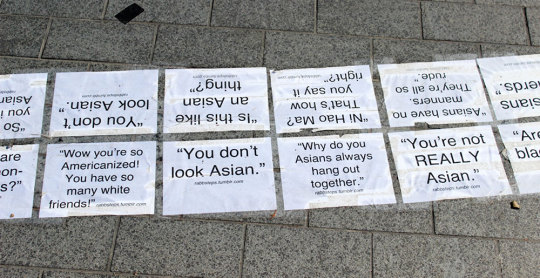
[ Brandeis University microagression display, later declared a microagression (click image to enlarge) ]
Speaker disinvitations—cancellations of invited speakers—have been accelerating over the past decade. According to the Foundation for Individual Rights in Education (FIRE), 257 such incidents have occurred since 2000, 111 of which were successful in preventing the invited guests from giving their talks. In 2014, for example, Ayaan Hirsi Ali was invited to give the commencement speech at Brandies University, where she was to also receive an honorary doctorate. After students protested, citing her criticism of Islam for its mistreatment of women, the administration caved into their demands and Ali was no-platformed (as it is called in England). Worse, in this theater of the absurd, students from U.C. Berkeley attempted to no-platform the comedian and social commentator Bill Maher for his alleged “Islamophobia,” code for anyone who criticizes Islam for any reason. Maher delivered his commencement oration nonetheless, telling the very liberal student body that “Liberals should own the First Amendment the way conservatives own the Second Amendment,” pointing out that apparently irony is no longer taught at this birthplace of the 1960’s free speech movement. This was topped by students at Williams College who, in October 2015, succeeded in disinviting Suzanne Venker, author of The Flipside of Feminism. Venker was invited to participate in the college’s “Uncomfortable Learning” lecture series but, well, she made some students feel too uncomfortable. “When you bring a misogynistic, white supremacist men’s rights activist to campus in the name of ‘dialogue’ and ‘the other side,’” whined one student on Facebook, it causes “actual mental, social, psychological, and physical harm to students.” Physically harm?
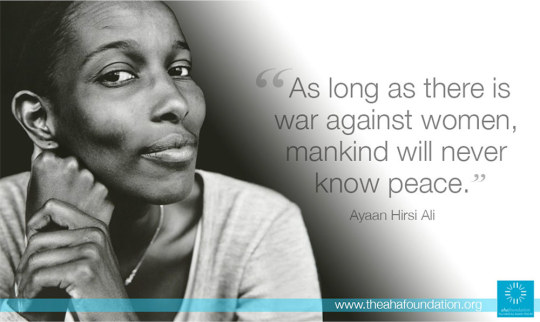
[ Banner from the website of Ayaan Hirsi Ali ]
The effects of such protests are often the opposite of what the protesters sought. Ayaan Hirsi Ali’s speech, for example, was printed in the Wall Street Journal where it was seen by that paper’s 2.37 million readers, many orders of magnitude more than would have heard it on campus. Bill Maher turned his Berkeley brouhaha into a bit for his HBO television show Real Time, which carries over four million viewers. More irony.
What may have started out as well intentioned actions at curbing prejudices and attenuating bigotry with the goal of making people more tolerant, has now metamorphosed into thought police attempting to impose totalitarian measures that result in silencing dissent of any kind. The result is the very opposite of what free speech and a college education is all about.
Why such unrest in the academy—among the most liberal institutions in the country—surrounded as these students are by so many liberal professors and administrators? Here I will offer five proximate (immediate) causes, one ultimate (deeper) cause, and some solutions.
Proximate Causes
1. Moral Progress
As I document in The Moral Arc, we have made so much moral progress since the Enlightenment—particularly since the civil rights and women’s rights movements that launched the modern campus protest movement in the first place—that our standards of what is tolerable have been ratcheted ever upward to the point where students are hypersensitive to things that, by comparison, didn’t even appear on the cultural radar half a century ago. This progress has happened gradually enough on the news cycle measure of days and weeks to be beneath the awareness of most observers, but fast enough that it can be tracked on time scales ranging from years to decades. For example, remember when interracial marriage was a divisive debate? Me neither. But recall the now-jarring words of the trial judge Leon M. Bazile, who convicted Richard and Mildred Loving in the case (Loving v. Virginia) that ultimately made its way to the Supreme Court in 1967 and overturned laws banning interracial marriage: “Almighty God created the races white, black, yellow, malay and red, and he placed them on separate continents. The fact that he separated the races shows that he did not intend for the races to mix.” Same-sex marriage went through a similar evolution as interracial marriage, culminating in the 5–4 decision by the Supreme Court of the United States in 2015 to make same-sex marriage the law of the land, another data point in the long-term trend toward granting more rights to more people.
Interracial marriage and same-sex marriage are themselves the legacy of the rights revolutions that first took off in the late 1700s when the idea of rights was invented and then demanded, first in the American Revolution (starting with the Declaration of Independence in 1776), then in the French Revolution (with the Declaration of the Rights of Man and of the Citizen in 1789), inspiring subsequent rights revolutions and documents (for example, Declaration of the Rights of Woman in 1791). The result, two and a half centuries later, has been the abolition of slavery, the eradication of torture, the elimination of the death penalty in all modern democracies save America, the franchise for all adult citizens, children’s rights, women’s rights, gay rights, animal rights, and even the rights of future generations to inhabit a livable planet. Who knows, perhaps one day soon we’ll even grant rights to Artificially Intelligent robots. In other words, most of the big moral movements have been fought and won, leaving today’s students with comparatively smaller causes to promote and evils to protest, but with moral emotions just as powerful as those of previous generations, so their outrage seems disproportionate.
2. Transition from a Culture of Honor to a Culture of Victimhood
In a culture of honor one settles minor disputes oneself and leaves the big crimes to the criminal justice system. Over the past two decades this has been eroded and is being replaced by a culture of victimhood in which one turns to parent-like authorities (faculty and college administrators, but not the law) to settle minor disputes over insults and slights.2 The culture of honor leads to autonomy, independence, self-reliance, and self-esteem, whereas the culture of victimhood leads to dependence and puerile reliance on parental figures to solve ones’ problems. In this victimhood culture the primary way to gain status is to either be a victim or to condemn alleged perpetrators against victims, leading to an accelerating search for both.3 A student at the University of Oxford named Eleanor Sharman explained how it happened to her after she joined a campus feminist group named Cuntry Living and started reading their literature on misogyny and patriarchy:
Along with all of this, my view of women changed. I stopped thinking about empowerment and started to see women as vulnerable, mistreated victims. I came to see women as physically fragile, delicate, butterfly-like creatures struggling in the cruel net of patriarchy. I began to see male entitlement everywhere.
As a result she became fearful and timid, afraid even to go out to socialize:
Feminism had not empowered me to take on the world—it had not made me stronger, fiercer or tougher. Even leaving the house became a minefield. What if a man whistled at me? What if someone looked me up and down? How was I supposed to deal with that? This fearmongering had turned me into a timid, stay-at-home, emotionally fragile bore.
It is not that there are no longer real victims of actual crimes, but it is a disservice to them to equate the trivial peccadillos of microaggressions or triggering words with brutal rapes and murders. A feminist named Melody Hensley, for example, who was once the Executive Director of the Center for Inquiry in Washington DC. claims that years of online stalking and social media trolls gave her PTSD on par with that of combat soldiers, disabling her from being able to work. Not surprisingly, war vets were not sympathetic.
3. From Anti-Fragile to Fragile Children
One response to the 1970s and 1980s crime wave was a shift toward “helicopter parenting” in which children were no longer allowed to be, well, children. The social psychologist Jonathan Haidt explains why through the concept of anti-fragility: “Bone is anti-fragile. If you treat it gently, it will get brittle and break. Bone actually needs to get banged around to toughen up. And so do children. I’m not saying they need to be spanked or beaten, but they need to have a lot of unsupervised time, to get in over their heads and get themselves out. And that greatly decreased in the 1980s. Anxiety, fragility and psychological weakness have skyrocketed in the last 15–20 years.” Those kids are today’s college students, and as a consequence they have brittle bones and thin skins. An example of an anti-fragile person with strong bones and thick skin is the model Isabelle Boemeke, who tweeted what she does when verbally harassed on the streets by ogling men:
Here’s what I do when catcalled: roll my eyes, if he’s Hispanic say “chinga tú madre!”, put earphones on, continue with life.
— Isabelle Boemeke (@isaboemeke) February 10, 2016
4. Puritanical Purging
Social movements tend to turn on themselves in puritanical purging of anyone who falls short of moral perfection, leading to preemptive denunciations of others before one is so denounced. The witch crazes of the 17th century degenerated into such anticipatory condemnations, resulting in a veritable plethora of nonexistent sorceresses being strapped to faggots and torched. The 20th century witnessed Marxist and feminist groups undergoing similar purges as members competed for who was the purist and defenestrated those who fell below the unrealizable standard. On the other side of the political spectrum, Ayn Rand’s objectivist movement took off in a frenzied build up after the publication of Atlas Shrugged in 1959, but by the time the philosopher-novelist died in 1982 most of the insider “collective” had been expunged for various sins against the philosophy, from listening to the wrong music to challenging the founder on any point of substance or minutia. Such purification purges are among the worst things that can happen to a social movement.
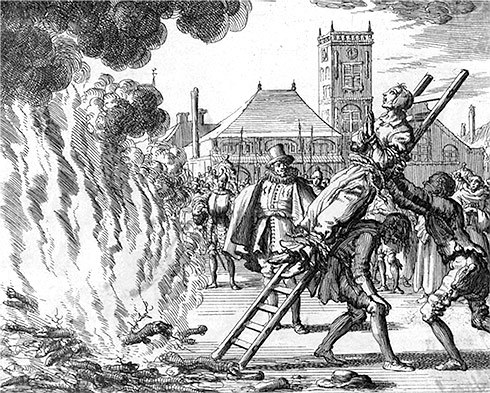
[ Pre-emptive denunciations lead to witch hunts. ]
5. Virtue Signaling
Related to puritanical purging is virtue signaling, in which members of a movement compete to signal who is the most righteous by (A) recounting all the moral acts one has performed and (B) identifying all the immoral acts others have committed. This leads to an arms-race to signal moral outrage over increasingly diminishing transgressions, such as unapproved Halloween costumes at Yale University, which led to a student paroxysm against a faculty member, a cell-phone video of which went viral and nearly brought the campus to a stand still. This is an example of what Maajid Nawaz means by “regressive liberalism,” where freedom of speech and expression are sacrificed in the name of tolerance, which is actually intolerance. One of the first acts of totalitarian regimes is to restrict dissent and free speech, so perhaps it should be called totalitarian liberalism.
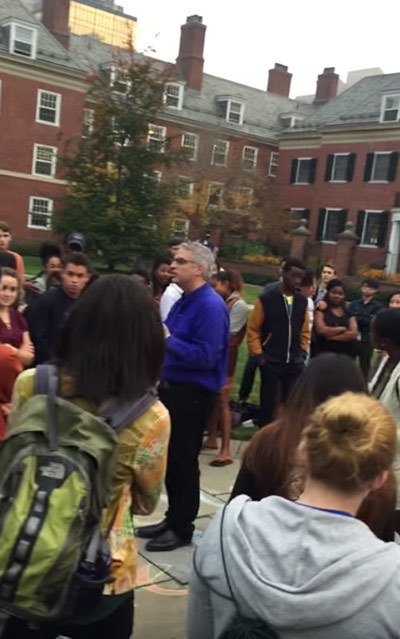
[ Yale college master Nicholas Christakis (in blue shirt) is verbally assaulted by a student who accused him of not doing enough to censor the wearing of Halloween costumes that could be seen as offensive. “Who the fuck hired you?” the girl with the backpack screamed at the professor. ]
An Ultimate Cause
A deeper reason behind the campus problem is a lack of diversity. Not ethnic, race, or gender diversity, but viewpoint diversity, specifically, political viewpoint. The asymmetry is startling. A 2014 study conducted by UCLA’s Higher Education Research Institute found that 59.8 percent of all undergraduate faculty nationwide identify as far left or liberal, compared with only 12.8 percent as far right or conservative. In a 2015 study published in Behavioral and Brain Sciences Arizona State University psychologist José Duarte and his colleagues reported that 58–66 percent of social science professors identify as liberals, compared to only 5-8 percent as conservatives. Given the power of beliefs to drive actions, college students today stand next to no chance of receiving a balanced education on the most important topics of our time and for which social science is best equipped to study.
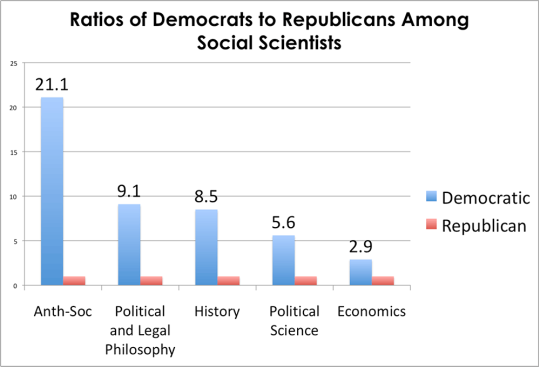
[ This graph captures the political bias problem well. From: Klein, Daniel B. and Charlotte Stern. “Professors and Their Politics: The Policy Views of Social Scientists.” Critical Review, 17, p. 264. (click image to enlarge) ]
What goes around comes around. Today’s liberal college professors were radical college students in the 1960s and 1970s, protesting “the man” and bucking authority. One reason faculty and administrators are failing to stand up to student demands today is that they once wore those shoes. Raising children and students to be dismissive of law and order and mores and manners leads to a crisis in consciousness and the rejection of the very freedoms so hard won by their parents and teachers. A generation in rebellion gave birth to a generation in crisis. Thus it is that the revolution devours its children.
Solutions
There is no magic bullet solution to the problems the academy faces today, but as liberals have known for some time it takes decades—even generations—to right the wrongs of the past, so solutions are likely to be incremental and gradual, which is almost always a good thing when it comes to social change, as it leads to less violent and more peaceful actions on the part of both activists and their opponents. Contra Barry Goldwater, extremism in the defense of liberty is no virtue; moderation in the pursuit of justice is no vice.4
Hiring practices fall under this rubric. If the academy is already comfortable with and active in seeking to diversify its faculty by ethnicity, race, and gender, why not viewpoint as well? Given the entrenchment of tenure this will take time, but as that scribe of moral progress Victor Hugo observed, “Nothing is more powerful than an idea whose time has come.”5
In the meantime, viewpoint diversity can be increased almost overnight by inviting speakers from a wide range of perspectives—political, economic, and ideological—even if (or especially) if they are offensive to faculty and students. And no more disinvitations! If you invite someone to speak, honor your word, own your decision, and stand up to the cry bullies (as they’re called in this neologism). The assignment of books and papers for students to read—especially for courses in history, English literature, the humanities, and the social sciences—can and should include authors whose positions are at odds with those of most academicians and student bodies. And professors: in addition to assigning students articles and opinion editorials from the New York Times, give them a few from the Wall Street Journal. Balance The Nation magazine with Reason magazine, The American Prospect with The American Spectator, National Public Radio with Conservative Talk Radio, PBS with Fox News.
Viewpoint diversity, however, is subservient to the deeper principle of free speech, which should be applied indiscriminately across the academy, as it should across society and, ideally, the world. What does free speech mean? First, it does not mean that you can lie about someone. Libel laws are in place to protect people from defamation that causes reputational and financial harm. Second, free speech does not mean that the government, public institutions, or private persons, businesses, or publications are required to promote or publish the opinions of others. As the Publisher of Skeptic magazine, for example, it is not incumbent on me to publish articles or accept advertisements just because we’re in the business of publishing. Institutions should have the freedom to restrict the speech of anyone who utilizes resources within the jurisdiction of its own institution, such as a school newspaper. The government, however, cannot restrict citizens’ speech just because it finds their opinions distasteful, offensive, or critical of its policies. (Exceptions have been made for treason and the passing on of national secrets to enemies, but crying “fire” in a crowded theater was most likely an exception that proves the rule.)
Holocaust deniers, creationists, and 9/11 truthers, for example, should have the right to publish their own journals and books, and to attempt to have their views aired in other publications and media venues, as in college newspapers and web sites, but no one is obligated to publish them. Alex Grobman and I wrestled with the free speech issue in our 2004 book Denying History: Who Says the Holocaust Never Happened and Why Do They Say It? As we opined: “Being in favor of someone’s right to freedom of speech is quite different from enabling that speech.” But we chose to write a book about their movement and arguments, quoting them extensively because, we believe, “In the bright light of open discussion the truth will emerge.”6 And although I declined to publish an ad submitted by a Holocaust denier in Skeptic (running an advertisement in our magazines carries the imprimatur of endorsement), I did debate Mark Weber, the director of the Institute for Historical Review (the leading Holocaust denier organization) in a public forum they hosted.
The freedom of speech has been one of the driving forces behind moral progress because it enables the search for truth. How? There are at least five reasons:7
We might be completely right but still learn something new.
We might be partially wrong and by listening to other viewpoints we might stand corrected and refine and improve our beliefs. No one is omniscient.
We might be completely wrong, so hearing criticism or counterpoint gives us the opportunity to change our minds and improve our thinking. No one is infallible. The only way to find out if you’ve gone off the rails is to get feedback on your beliefs, opinions, and even your facts.
Whether right or wrong, by listening to the opinions of others we have the opportunity to develop stronger arguments and build better facts for our positions. You know that the world is round and goes around the sun, that evolution is real, and that the Holocaust happened. But can you explain how you know these facts? What are the best arguments and evidences for these facts? Could you articulate them clearly and succinctly in a debate or conversation? As John Stuart Mill noted in his classic 1859 work On Liberty: “He who knows only his own side of the case, knows little of that.”
My freedom to speak and dissent is inextricably tied to your freedom to speak and dissent. Once customs and laws are in place to silence someone on one topic, what’s to stop people from silencing anyone on any topic that deviates from the accepted canon? The justification of censorship laws in the consequentialist argument that people might be incited to discrimination, hate, or violence if exposed to such ideas fails the moment you turn the argument around and ask: What happens when it is you and your ideas that are determined to be dangerous? It is the Principle of Interchangeable Perspectives that I introduced in The Moral Arc: For me to expect you to listen to me I must be willing to hear you. If I censor you, why shouldn’t you censor me? If you silence me, why shouldn’t I silence you?
This argument against censorship was well articulated in Robert Bolt’s 1960 play, A Man for All Seasons, based on the true story of the 16th century Chancellor of England, Sir Thomas More, and his collision with King Henry VIII over the monarch’s divorce from Catherine of Aragon. In the play a dialogue unfolds between More and his future son-in-law Roper, who urges him to arrest a man whose testimony could condemn More to death, even though no laws were broken. “And go he should, if he were the Devil himself, until he broke the law!” More entices.
Roper: So now you’d give the Devil benefit of law!
More: Yes. What would you do? Cut a great road through the law to get after the Devil?
Roper: I’d cut down every law in England to do that.
More: Oh? And when the law was down, and the Devil turned round on you—where would you hide, Roper, the laws all being flat? This country is planted thick with laws from coast to coast…and if you cut them down…do you really think you could stand upright in the winds that would blow then? Yes, I’d give the Devil benefit of law, for my own safety’s sake.8
For our own safety’s sake we must grant our devils their due.
#Michael Shermer#academic corruption#student fragility#emotional fragility#censorship#trigger warnings#speech codes#academic freedom#freedom of speech#free speech#academic integrity#long post#religion is a mental illness
16 notes
·
View notes
Note
Going back to early BCS, but was Domingo and Nacho's relationship ever the same after he beat him down? On some level did Nacho want his childhood friend to be afraid of him?
My headcanon is that Nacho was extremely against Domingo getting into the drug business. From Domingo's convo with Walt, we know that Domingo is a college graduate, and apparently had musical talent impressive enough to seriously consider attending Oberlin, one of the most prestiguous conservatories in the country. Domingo was set up for success in the straight world. Nacho didn't want his friend following him into crime
But Domingo kept insisting, probably out of some sense of rebellion against his dad (who talked him out of Oberlin). I think by the BCS timeline, Nacho has washed his hands of Domingo's decisions and is like "you want to be street dealer? Fine. I'll treat you like one," maybe hoping Domingo gets traumatized and goes back to a normal life. But of course there's no easy exit from the drug business, and Domingo is really determined to be a cool gangster
56 notes
·
View notes
Text
They present themselves as rebels against the system, fighting to preserve a piece of local woodland.
Yet many of the terrorist suspects arrested and charged over occupying government property and the violent attack in downtown Atlanta on Saturday are children of pampered privilege from out of state.
Hundreds of far-left activists, including Antifa, had gathered on Saturday evening at the Five Points neighborhood in downtown Atlanta to protest the death of their comrade who died in a shootout with police earlier in the week at an occupation south of the city.
On Jan. 18, Manuel Esteban Paez Teran, of Tallahasse, Fla., shot and severely injured a Georgia State Patrol trooper at the so-called “autonomous zone” before being killed by returning fire from police. The year-and-a-half long occupation is at the heart of the “Stop Cop City” movement to shut down the construction of the future Atlanta Public Safety Training Center, a proposed training site for law enforcement and first responders. They hate it because it’s a police center, but also claim that they are protecting a forest.
At Saturday’s gathering, masked militants dressed head to toe in black marched in the streets, shouting: “If you build it, we will burn it.”
They then smashed up businesses, cars and the Atlanta Police Foundation building. An Atlanta police cruiser was set on fire with an explosive. Livestream videos recorded at the scene showed the violent extremists working in an organized manner, such as using a large vigil banner to hide the rioters who torched the vehicle and grabbing large rocks from a shared bag to use as projectiles.
Some of those arrested represent the sort of professional leftist agitator who have popped up across the country after George Floyd’s death:
Francis Carroll is the son of a yacht-sailing, multi-millionaire family.
Carroll was already out on bail for a domestic terrorism arrest at the Atlanta autonomous zone last month. He is the son of a yacht-sailing, multi-millionaire family and hails from the wealthy Maine city of Kennebunkport, also home to former president George W. Bush.
Carroll, who lived in his parent’s mansion before going to Atlanta, was among six people arrested and charged with domestic terrorism, aggravated assault and other crimes on Dec. 13 following a string of property attacks around the area, a carjacking and assaults on officers. They were all bailed out by activists who crowdfunded their legal defense using Twitter.
Madeleine “Henri” Feola is orginally from the wealthy Portland, Ore., suburb of Happy Valley.
Feola is a trans nonbinary activist and 2022 alumna of Oberlin College, where they studied archaeological studies with a focus on decolonization. They’re from the wealthy Portland, Ore., suburb of Happy Valley before relocating to Spokane, Wash. Feola authored a February 2022 blog post on the American Scientist titled, “It’s Time to Stop Gatekeeping Medical Transition.”
Emily Kathryn Murphy says her own family “doesn’t fully understand what being vegan means.”
Murphy is a middle-class vegan activist who previously served as the at-large chair for the Chicago chapter of Al Gore’s “Climate Reality Project” organization before becoming further radicalized into eco-ideology. “I have been vegan five and a half years now, and, no matter how much explaining I do, my own family still doesn’t fully understand what being vegan means,” Murphy complained once in a blog post for the group.
Ivan James Ferguson is an award-winning classically trained clarinet player.
Ferguson is a 23-year-old award-winning classically trained clarinettist from Henderson, Nev. who studied at the prestigious San Francisco Conservatory of Music. Before becoming radicalized, Ferguson regularly performed in classical concerts in California and Nevada.
They’ve each been charged with: felony domestic terrorism, felony interference with government property, felony first-degree arson, felony second-degree criminal damage, riot, unlawful assembly, willful obstruction of a law enforcement officer and pedestrian in roadway.
At an emergency press conference following the riot, Atlanta mayor Andre Dickens revealed a shocking discovery: “Some of them were found with explosives on them. You heard that correctly, explosives.”
The Georgia Bureau of Investigation and other law enforcement agencies have tried multiple times to end the violent occupation of the woods. Yet militants have regrouped and continued to occupy the area, heeding the call shared on anarchist sites for comrades to “defend the Atlanta forest.” At the first police raid in May 2022, police were met with Molotov cocktails. The GBI also said it found gas masks and edged weapons at the raid.
During the protest, an Atlanta police cruiser was set on fire with an explosive.FOX 5
Among the previous arrests were more privileged protesters:
* Teresa Yue Shen, a Brooklyn woman arrested on Jan. 18 who graduated from Barnard College before working at Reuters and CNN, according to her LinkedIn. She is charged with domestic terrorism.
* Abigail Elizabeth Skapyak, of Minneapolis. Skapyak is a former Justice Department intern who graduated from American University. She was arrested on May 17.
* Marianna Hoitt-Lange, a violinist who graduated from New York University. She was arrested on May 17.
* Madeleine “Matthias” Gunther Kodat, of Philadelphia, is the daughter of the former provost and dean of faculty at Lawrence University in Appleton, Wis. who was arrested on May 17.
Protesters torch police car, damage businesses in Atlanta after activist killed
In November, rioters tried to set a man on fire who drove into the area.
“It seemed to me like they were going to burn the truck with me in it,” Richard Porter told 11Alive News at the time. He was forced to flee for his life as his truck was torched. In early December, two under-construction homes next to the occupation were burned to the ground. The same month, another raid resulted in six being arrested and charged with domestic terrorism.
Serena Hertal, of Sun Valley, Idaho, was one of the militants charged with domestic terrorism, aggravated assault and criminal trespass. She graduated from Pitzer College, a private liberal arts university in Claremont, Calif. where yearly costs are over $82,000.In addition to the weekend violence in Atlanta over the shooting death of the gunman, far-left sympathizers from around the country have held solidarity direct actions and urged retributive violence. “Scenes from the Atlanta Forest,” a collective that represents the autonomous zone, called for “reciprocal violence” against police in a heavily shared post on Twitter.
In solidarity with the Atlanta occupation, the trans child of Democratic House Minority Whip Katherine Clark was arrested for alleged vandalism and assault of an officer. Jared “Riley” Dowell, 23, was charged with assault by means of a dangerous weapon, destruction of injury of personal property and damage of property by graffiti.
In Lansing, militants attacked a bank, writing, “Stop cop city.” Six were arrested. A Portland UPS center was also purportedly set on fire, with a claim of responsibility posted online saying it was retribution over their comrade’s death.
“We call for more actions directly toward the companies that are donating to and funding the Cop City project in Atlanta. Forest defenders have a right to stay in the forest, and groups will continue to retaliate until the Cop City Project is canceled,” reads the anonymous statement.
26 notes
·
View notes
Text
i was in THE MIDDLE of putting together my cover letter and resume for a position in the OBERLIN COLLEGE AND CONSERVATORY LIBRARY and my ipad imploded 😐🔫
#IT PAYS SO GOOD? REQUIRES ALMOST NO SPECIFIC EXPERIENCE OF ANY KIND?#oberlin is kind of far from jake but the pay is so good i could probably get my own place way faster#t
4 notes
·
View notes
Photo







“...mesmerizing artistic simulations…” – NASA
Sage Jenson is a media artist focused on speculative biology and emotive simulation. Their work involves tactile audiovisual spaces, complex systems, and the cultivation of digital creatures and ecosystems. Their ongoing simulation project traces a common living thread through material structures spanning time and space.Sage’s work has been shown internationally at venues and festivals such as the Barbican Theater, Sundance, and Lyon’s Fête des Lumières, among others. They have published in the fields of geometry processing, complex network theory, and human-computer interaction.
https://feralfile.com/
https://cargocollective.com/sagejenson
Sage received a BA and BM from Oberlin College and Conservatory, where they studied mathematics, computer science, and electroacoustic music. In addition to their solo practice, Sage has worked in the field of computational geometry and architecture, most recently with Neri Oxman. Sage lives on a brackish marsh near New York City.
11 notes
·
View notes
Text
George Walker was a pioneering American composer, pianist, and educator who made history by becoming the first African American to win the Pulitzer Prize for music. His groundbreaking work and achievements have left a lasting impact on the world of classical music.
Early life and Education
George Theophilus Walker was born on June 27, 1922, in Washington, D.C. His mother, Rosa King Walker, was a piano teacher, and his father, George Walker, Sr., was a physician. From a young age, Walker showed exceptional musical talent and began studying piano with his mother at the age of five.
After graduating from Dunbar High School, Walker went on to study at the Oberlin Conservatory of music, where he earned a Bachelor of music degree in 1941. He then continued his studies at the Curtis Institute of music in Philadelphia, where he studied piano with Rudolf Serkin and composition with Rosario Scalero.
music Career
Throughout his career, George Walker composed over 90 works, including symphonies, chamber music, piano pieces, and vocal works. His music is known for its emotional depth, lyrical beauty, and innovative use of harmony and form.
One of Walker's most famous works is his "Lilacs" for voice and orchestra, which was inspired by the poem of the same name by Walt Whitman. The piece was premiered by the Boston Symphony Orchestra in 1996 and has since become a staple of the American classical music repertoire.
Pulitzer Prize Win
In 1996, George Walker made history by becoming the first African American to win the Pulitzer Prize for music for his composition "Lilacs." The award was a groundbreaking moment in the history of classical music and brought Walker's work to a wider audience.
Upon receiving the Pulitzer Prize, Walker said, "I hope this will encourage black composers who have been overlooked. I hope it will encourage young composers, black and white."
Legacy and Impact
George Walker's legacy extends far beyond his Pulitzer Prize win. He was a trailblazer for African American composers and musicians, breaking down barriers and paving the way for future generations. His music continues to be performed and celebrated around the world, ensuring that his contributions to the classical music canon will never be forgotten.
In addition to his work as a composer, Walker was also a dedicated educator, teaching at prestigious institutions such as the Peabody Institute, Rutgers University, and the Smith College Department of music.
FAQs
Q: What other awards did George Walker win during his career?
A: In addition to the Pulitzer Prize, George Walker was the recipient of numerous other awards and honors, including the American Academy of Arts and Letters Award, the Fromm music Foundation Award, and the Guggenheim Fellowship.
Q: Was George Walker the only member of his family involved in music?
A: No, George Walker came from a musical family. His mother, Rosa King Walker, was a piano teacher, and his brother, Dr. Hugh Walker, was a violinist and musicologist.
Q: What is George Walker's most famous composition?
A: While "Lilacs" is perhaps George Walker's most famous composition, he composed many other notable works, including his Piano Sonata No. 1, his String Quartet No. 1, and his Sinfonia No. 4.
0 notes
Text
youtube
Cécile McLorin Salvant's album Mélusine was released one year ago this week. To mark the occasion, we're sharing live performances of four songs from the album made at Oberlin College & Conservatory, starting with "Dites moi que je suis belle," featuring Weedie Braimah on djembe.
#cecile mclorin salvant#melusine#live music#jazz#weedie braimah#djembe#oberlin college#oberlin conservatory#nonesuch#nonesuch records#Youtube
0 notes
Text
Nicholas Muni
Website: https://www.phillyflair.com/nicholas-muni-on-his-new-version-of-orphee-aux-enfers-by-jacques-offenbach/
Address: Delray Beach, Florida
Muni, a luminary in the opera industry, shares his wealth of experience, offering insights from opera beginnings to advanced singing and acting skills. Originating from New Jersey, Nicholas Muni’s professional journey commenced at Oberlin Conservatory. Nicholas Muni furthered his studies and engaged in various projects, notably with the National Endowment for the Arts. Nicholas Muni’s impactful tenure in Tulsa featured innovative productions, like The Spanish Trilogy, later showcased across North America. With over 300 productions globally, Nicholas Muni remains a sought-after authority, now contributing to opera education.
#Music#Nicholas Muni
LinkedIn: https://www.linkedin.com/in/nic-muni-579a5014
1 note
·
View note
Text
Nicholas Muni
Website: https://nicholasmuni.wordpress.com/
Address: Delray Beach, Florida
Nicholas Muni, a luminary in the opera industry, shares his wealth of experience, offering insights from opera beginnings to advanced singing and acting skills. Originating from New Jersey, Nicholas Muni’s professional journey commenced at Oberlin Conservatory. Nicholas Muni furthered his studies and engaged in various projects, notably with the National Endowment for the Arts. Nicholas Muni’s impactful tenure in Tulsa featured innovative productions, like The Spanish Trilogy, later showcased across North America. With over 300 productions globally, Nicholas Muni remains a sought-after authority, now contributing to opera education.
LinkedIn: https://www.linkedin.com/in/nic-muni-579a5014
1 note
·
View note
Text

Denyce Graves-Montgomery (born March 7, 1964) is a renowned mezzo-soprano opera singer. She has performed at opera houses around the world and is known for her roles in Carmen and Samson et Dalila.
She was born to Charles Graves and Dorothy Graves-Kenner in DC. She was raised by her mother in Southeast Washington, the middle child of three. She attended the Duke Ellington School of the Arts from which she graduated. She studied voice at the Oberlin Conservatory of Music and the New England Conservatory. She received an honorary doctorate from Oberlin for her accomplishments.
Her major career break came in 1995 when she performed at the Metropolitan Opera in the role of Carmen. She was hailed by opera critics and her audience.
She has become well-known outside of the world of opera and expanded her musical range to include gospel and patriotic music. She has been invited to perform at the White House numerous times and often gives performances to raise funds for charitable causes, with the most notable being a series of performances after the tragic events that took place on September 11th, 2001.
She became a Cultural Ambassador for the US and traveled to Poland, Venezuela, and Romania for the State Department. She has appeared on popular television shows like The Oprah Winfrey Show, Larry King Live, and Sesame Street, and she was the subject of an award-winning profile on 60 Minutes. She helped to open the new National Museum of African American History and Culture. She sang “Lift Every Voice and Sing” with the Voices of Tomorrow Choir at the dedication ceremony.
She faced multiple health and personal obstacles to continue working and performing. Her vocal cords became injured and started bleeding, causing her to undergo surgery and cancel months of performances. She married David Perry (1990-2001) a classical guitarist who became her business partner. She has one child, a daughter. She married Dr. Robert Montgomery (2009). She is an instructor at the Johns Hopkins Peabody Institute where she is a voice teacher. #africanhistory365 #africanexcellence #womenhistorymonth
1 note
·
View note